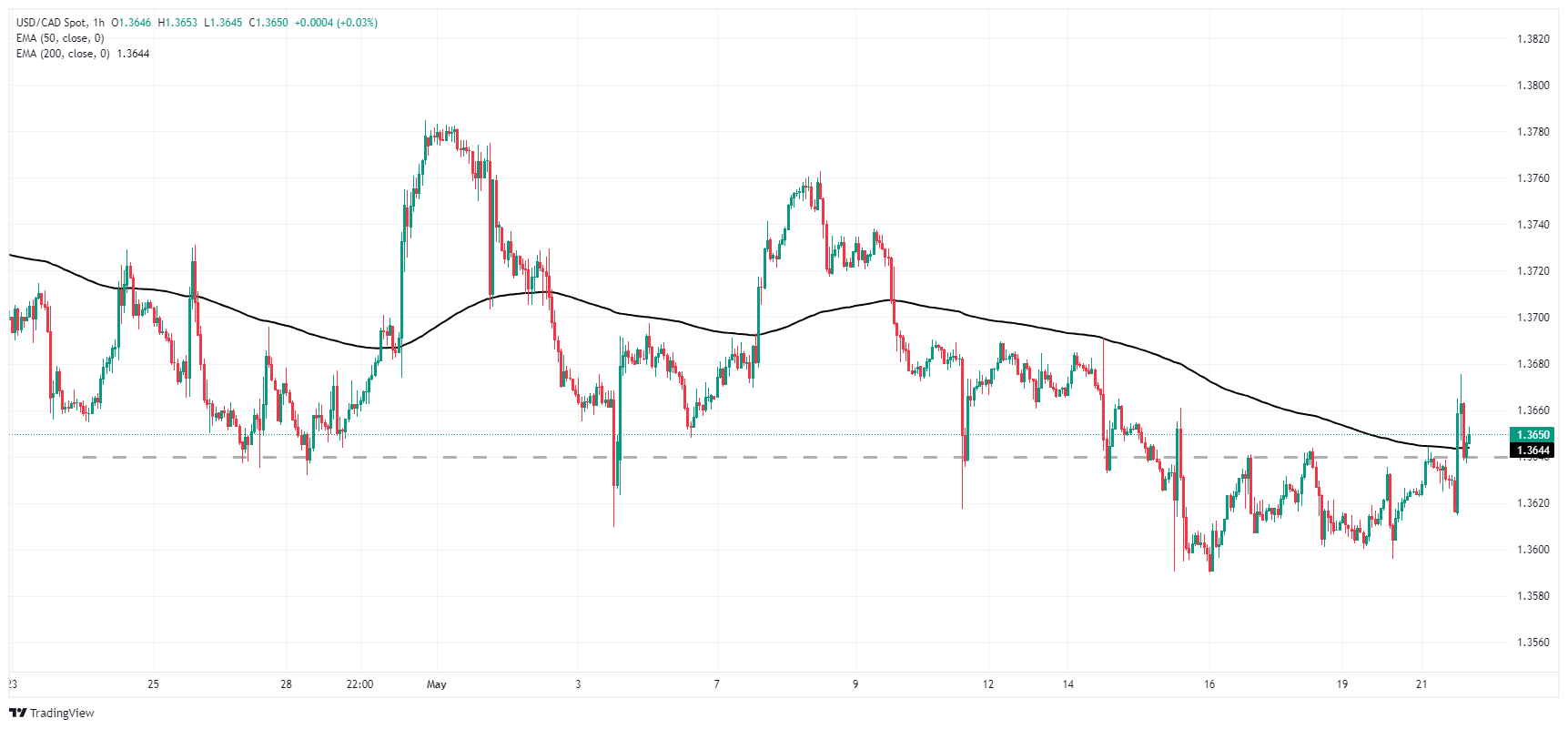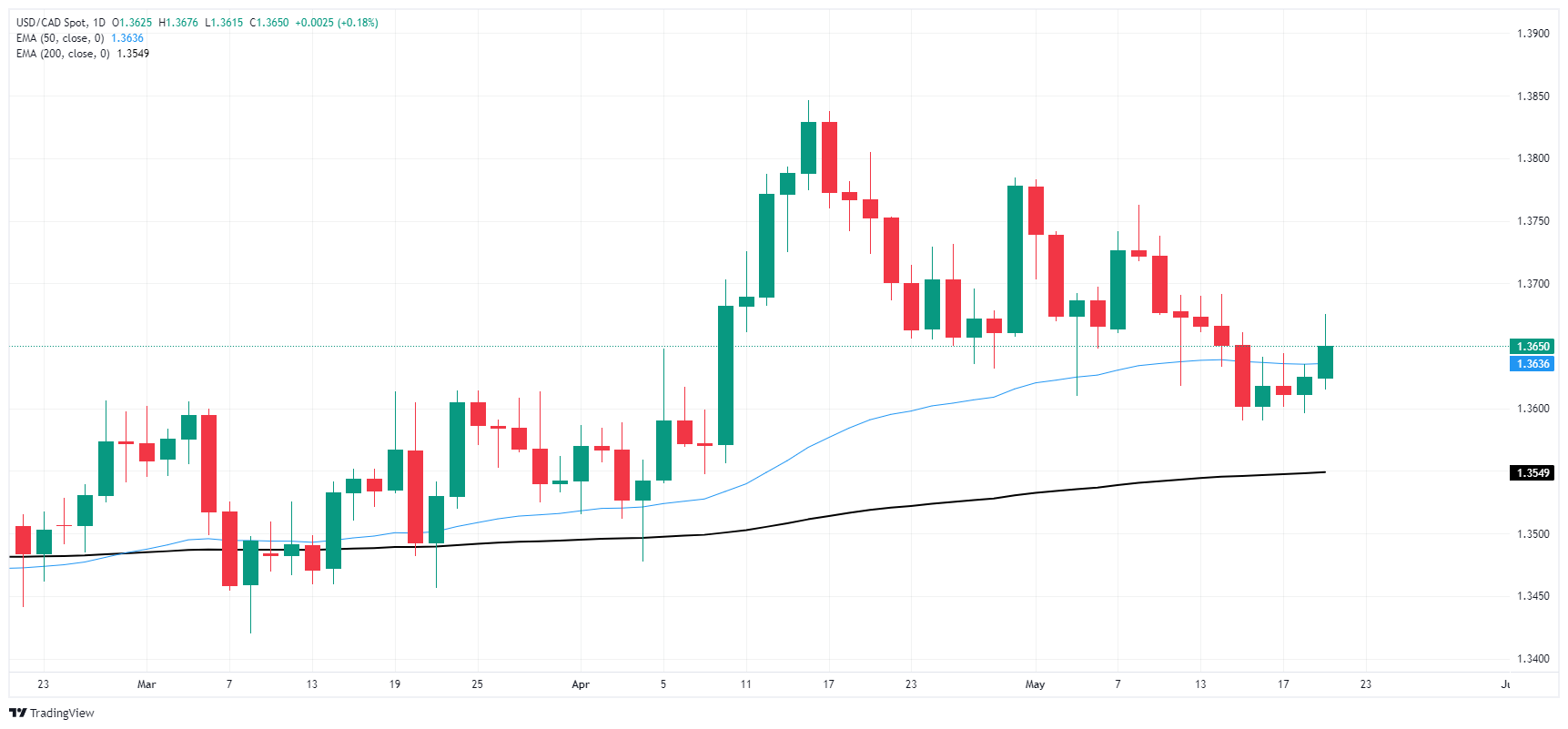- Analiza
- Novosti i instrumenti
- Vesti sa tržišta
- Canadian Dollar eases back on Tuesday after CPI inflation cools
Canadian Dollar eases back on Tuesday after CPI inflation cools
- Canadian Dollar broadly lower as inflation tempers in April.
- Canada finds easing price pressures, odds of BoC June rate cut rise.
- Canadian Retail Sales due at the end of the week.
The Canadian Dollar (CAD) is broadly softer on Tuesday, falling across the board and deflating around a fifth of a percent against the US Dollar (USD) after Canadian Consumer Price Index (CPI) inflation eased further in April. Markets are increasing their bets of a rate cut from the Bank of Canada (BoC) in June.
Canadian CPI inflation eased broadly in line with expectations, but the BoC’s Core CPI print dropped to its lowest point since April of 2021. With price pressure easing, market bets of a June rate cut from the BoC have risen to 48%, from 40% prior to Canada’s CPI print.
Daily digest market movers: Canadian Dollar slides in the face of easing inflation
- Canadian headline CPI inflation in April ticked down to 0.5% MoM, matching forecasts and easing from the previous 0.6%.
- YoY Canadian CPI inflation also met market forecasts, printing at 2.7% versus the previous 2.9%.
- The BoC’s Core CPI for the year ended April eased to 1.6%, down from the previous 2.0% and hitting a three-year low.
- Elsewhere in the market, Fedspeak continues to dominate overall sentiment as policymakers from the US Federal Reserve (Fed) make a slew of appearances in an effort to inject verbal confidence in markets.
- Canadian Retail Sales are due at the end of the week. Median market forecasts are hoping for a slight rebound to a flat 0.0% from the previous -0.1%.
Canadian Dollar PRICE Today
The table below shows the percentage change of Canadian Dollar (CAD) against listed major currencies today. Canadian Dollar was the strongest against the New Zealand Dollar.
| USD | EUR | GBP | JPY | CAD | AUD | NZD | CHF | |
|---|---|---|---|---|---|---|---|---|
| USD | 0.00% | -0.04% | -0.08% | 0.16% | 0.01% | 0.16% | 0.00% | |
| EUR | -0.01% | -0.04% | -0.08% | 0.14% | 0.04% | 0.13% | 0.01% | |
| GBP | 0.04% | 0.04% | -0.06% | 0.20% | 0.05% | 0.19% | 0.04% | |
| JPY | 0.08% | 0.08% | 0.06% | 0.25% | 0.08% | 0.22% | 0.08% | |
| CAD | -0.16% | -0.14% | -0.20% | -0.25% | -0.15% | -0.01% | -0.16% | |
| AUD | -0.01% | -0.04% | -0.05% | -0.08% | 0.15% | 0.14% | 0.00% | |
| NZD | -0.16% | -0.13% | -0.19% | -0.22% | 0.01% | -0.14% | -0.15% | |
| CHF | -0.00% | -0.01% | -0.04% | -0.08% | 0.16% | 0.00% | 0.15% |
The heat map shows percentage changes of major currencies against each other. The base currency is picked from the left column, while the quote currency is picked from the top row. For example, if you pick the Canadian Dollar from the left column and move along the horizontal line to the US Dollar, the percentage change displayed in the box will represent CAD (base)/USD (quote).
Technical analysis: Canadian Dollar backslides but remains in familiar technical territory
The Canadian Dollar (CAD) is moving in one direction on Tuesday, heading lower against nearly all of its major currency peers. The CAD is down a third of a percent against the broadly-recovering Japanese Yen (JPY), and has shed a fifth of a percent against the USD.
USD/CAD rose to its highest bids in a week, threatening to solidify a bullish rejection from the 50-day Exponential Moving Average (EMA) from 1.3636. The pair is still down from last month’s peak bids near 1.3850, but a long-term technical floor is priced in at the 200-day EMA from 1.3549.
USD/CAD hourly chart
USD/CAD daily chart
Canadian Dollar FAQs
The key factors driving the Canadian Dollar (CAD) are the level of interest rates set by the Bank of Canada (BoC), the price of Oil, Canada’s largest export, the health of its economy, inflation and the Trade Balance, which is the difference between the value of Canada’s exports versus its imports. Other factors include market sentiment – whether investors are taking on more risky assets (risk-on) or seeking safe-havens (risk-off) – with risk-on being CAD-positive. As its largest trading partner, the health of the US economy is also a key factor influencing the Canadian Dollar.
The Bank of Canada (BoC) has a significant influence on the Canadian Dollar by setting the level of interest rates that banks can lend to one another. This influences the level of interest rates for everyone. The main goal of the BoC is to maintain inflation at 1-3% by adjusting interest rates up or down. Relatively higher interest rates tend to be positive for the CAD. The Bank of Canada can also use quantitative easing and tightening to influence credit conditions, with the former CAD-negative and the latter CAD-positive.
The price of Oil is a key factor impacting the value of the Canadian Dollar. Petroleum is Canada’s biggest export, so Oil price tends to have an immediate impact on the CAD value. Generally, if Oil price rises CAD also goes up, as aggregate demand for the currency increases. The opposite is the case if the price of Oil falls. Higher Oil prices also tend to result in a greater likelihood of a positive Trade Balance, which is also supportive of the CAD.
While inflation had always traditionally been thought of as a negative factor for a currency since it lowers the value of money, the opposite has actually been the case in modern times with the relaxation of cross-border capital controls. Higher inflation tends to lead central banks to put up interest rates which attracts more capital inflows from global investors seeking a lucrative place to keep their money. This increases demand for the local currency, which in Canada’s case is the Canadian Dollar.
Macroeconomic data releases gauge the health of the economy and can have an impact on the Canadian Dollar. Indicators such as GDP, Manufacturing and Services PMIs, employment, and consumer sentiment surveys can all influence the direction of the CAD. A strong economy is good for the Canadian Dollar. Not only does it attract more foreign investment but it may encourage the Bank of Canada to put up interest rates, leading to a stronger currency. If economic data is weak, however, the CAD is likely to fall.
© 2000-2024. Sva prava zaštićena.
Sajt je vlasništvo kompanije Teletrade D.J. LLC 2351 LLC 2022 (Euro House, Richmond Hill Road, Kingstown, VC0100, St. Vincent and the Grenadines).
Svi podaci koji se nalaze na sajtu ne predstavljaju osnovu za donošenje investicionih odluka, već su informativnog karaktera.
The company does not serve or provide services to customers who are residents of the US, Canada, Iran, The Democratic People's Republic of Korea, Yemen and FATF blacklisted countries.
Izvršenje trgovinskih operacija sa finansijskim instrumentima upotrebom marginalne trgovine pruža velike mogućnosti i omogućava investitorima ostvarivanje visokih prihoda. Međutim, takav vid trgovine povezan je sa potencijalno visokim nivoom rizika od gubitka sredstava. Проведение торговых операций на финанcовых рынках c маржинальными финанcовыми инcтрументами открывает широкие возможноcти, и позволяет инвеcторам, готовым пойти на риcк, получать выcокую прибыль, но при этом неcет в cебе потенциально выcокий уровень риcка получения убытков. Iz tog razloga je pre započinjanja trgovine potrebno odlučiti o izboru odgovarajuće investicione strategije, uzimajući u obzir raspoložive resurse.
Upotreba informacija: U slučaju potpunog ili delimičnog preuzimanja i daljeg korišćenja materijala koji se nalazi na sajtu, potrebno je navesti link odgovarajuće stranice na sajtu kompanije TeleTrade-a kao izvora informacija. Upotreba materijala na internetu mora biti praćena hiper linkom do web stranice teletrade.org. Automatski uvoz materijala i informacija sa stranice je zabranjen.
Ako imate bilo kakvih pitanja, obratite nam se pr@teletrade.global.















